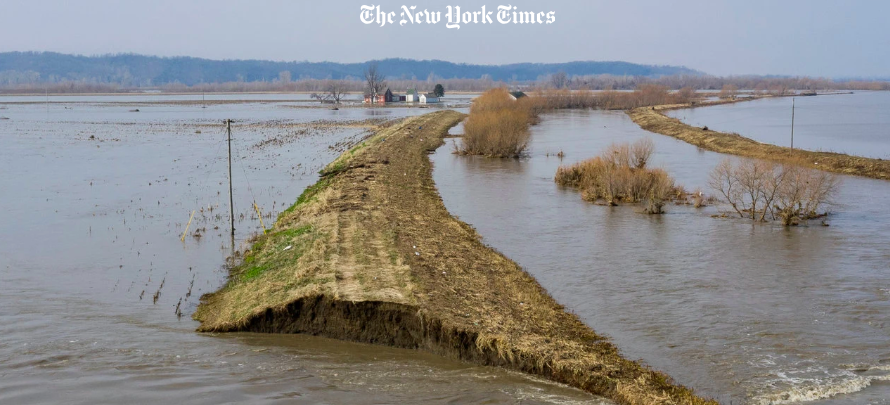
A Missouri River Breached Levee Photo: Tim Gruber, The New York Times
The U.S. flood control system of levees and dams is worn out and not up to the threat that climate change is posing. On Sunday, The New York Times reported that across the flooded Midwest, the vaunted federal levee system that was supposed to protect towns and farmland from devastating floods “is now so full of holes that many [there] ruefully describe it as ‘Swiss cheese,’” leaving many areas without flood protection at all. Constructed over the last fifty years at a cost of billions of taxpayer dollars, the thousands of miles of levees are now showing their age, are of varying levels of effectiveness, and because the storms we are seeing now are much more severe than what we anticipated when they were put in place.
- Indeed, levees may have actually the opposite of their intended effect. According to Nicholas Pinter, a geologist and the associate director of the Center for Watershed Sciences at the University of California, Davis, “What you’re doing in many cases is taking a flood plain out there — it can be 5 [or] 6 miles wide — and you’re forcing the water that would otherwise spread across that area to go through a narrow passageway.” As the passageway gets narrower, the water flows faster and higher and that pressure can then cause the levees to crack and break.
- Pinter told NPR last year that “the resulting floods are more severe than they would have been without the levees, which then drives people to build more levees, driving a ‘hydrologic spiral’ of flooding, levees, more flooding and higher levees.”
And the President spent time last Friday at Lake Okeechobee, Florida visiting the Herbert Hoover Dike, which protects surrounding communities from flooding, and taking credit for “making it stronger than it’s ever been.” The Dike is another disaster waiting to happen — Politico reported that the Corps of Engineers (the nation’s water infrastructure agency) listed it as one of the nation’s riskiest dams so now it is being strengthened (at a cost of $1.6 billion) in an effort to help provide storm protection in the region and reduce the harmful algal blooms that were devastating to the Florida tourism economy last year. The only problem is that the Trump Administration actually cut funding for the project, providing in its budget only $63 million of the $200 million Republican leaders in the state requested.
Why This Matters: Our aging water infrastructure has exacerbated climate disasters like the Midwestern floods and Florida’s toxic algal blooms — we must spend what is needed to repair and rebuild it. This is EXACTLY why a Green New Deal is not a radical or socialist policy. Without it, there will be more and worse climate disasters in the U.S. and more disaster victims. Moreover, disaster aid should not be withheld from any American — no matter where they live. Yesterday, Senate Republicans tried to jam through a disaster relief bill that, at President Trump’s urging, did not include sufficient funding for Hurricane Maria victims in Puerto Rico. Senate Democrats refused to support it because the island of Puerto Rico — a year and a half later — still needs our collective help. It incurred $90 billion in damages and many of its residents continue to struggle to get clean water, food, and medicine. Disaster relief and the enormous task of restoring our nation’s water infrastructure through legislation such as the Green New Deal both deserve better than the political games being played with them by Republicans.
To Go Deeper: Read the full NYT story on failed Midwestern levees here, and the NPR story on why levees don’t work here, and for a primer on levees, check out this story by The Associated Press.
April 2, 2019 » Green New Deal, Hurricane Maria, Lake Okeechobee, levees, Midwestern floods, Puerto Rico, water infrastructure


